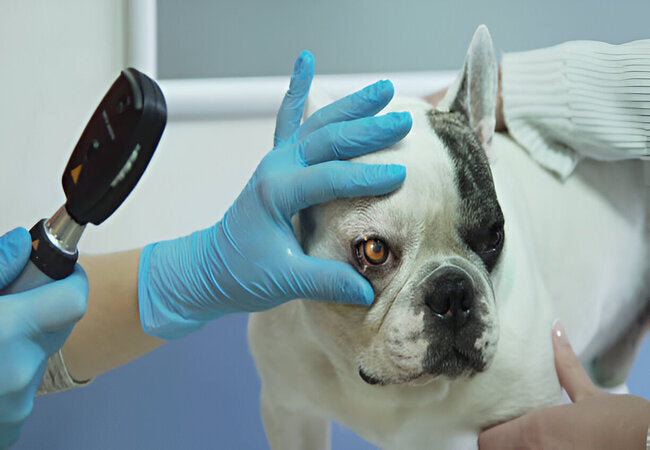Vet-Approved 2025 Guide: Eye Enucleation in Dogs & Cats – Compassionate Care & Recovery 🐶🐱

In this article
Vet-Approved 2025 Guide: Eye Enucleation in Dogs & Cats – Compassionate Care & Recovery 🐶🐱
By Dr. Duncan Houston BVSc
Eye enucleation—the complete surgical removal of the eye—is sometimes the most compassionate choice for blind, painful, or diseased eyes in dogs and cats. Though it can be a difficult decision, it's a well-accepted procedure that often dramatically improves quality of life. In this 2025 vet-approved guide, we explore everything from why and how enucleation is performed, to post-op care, prosthetic options, emotional support, and trusted resources like Ask A Vet. 🐶🐱❤️
🔍 Why Enucleation Might Be Recommended
Enucleation is indicated when an eye is irreversibly blind, painful, or poses ongoing health risks. Common causes include:
- End-stage glaucoma causes chronic pressure and pain.
- Severe trauma—rupture, proptosis, or ocular perforation.
- Untreatable intraocular infections or abscesses.
- Intraocular tumors with the potential to metastasize.
- Phthisis bulbi—painful, shrunken eye remnants.
- Severe corneal lacerations or ulcers are unresponsive to medical care.
🛠️ Surgical Techniques Explained
1. Transconjunctival (Subconjunctival) Approach
This method involves removing the eye through the conjunctiva, preserving surrounding tissues—reducing bleeding and cosmetic depression. However, it's unsuitable if infection or tumors are present, due to retained secretory tissue risks.
2. Transpalpebral Approach
This is the most versatile method—an elliptical incision is made around the eyelids and the entire eye plus all secretory tissues are removed as one unit. It minimizes residual tissue to reduce infection and fistula risk, though it may leave a slightly deeper post-op indentation.
3. Exenteration & Evisceration
In extreme cases, exenteration removes the globe and much of the orbital tissues—it’s reserved for invasive tumors or infections. Evisceration removes internal contents but leaves the sclera and muscles, offering pain relief while enabling prosthetic placement, but is contraindicated in tumor/infection cases.
🔬 Orbital Implants & Prosthetics
Placing a silicone or hydroxyapatite orbital implant during surgery helps maintain normal facial contours and supports a prosthetic eye later on. Once healed, a custom ocular prosthesis can restore eyelid movement and appearance, though vision won’t return.
📋 Step‑by‑Step Procedure Overview
- Preparation: General anesthesia, head positioning, eyelid clipping, and sterile povidone-iodine prep.
- Incision: Based on chosen approach—elliptical around eyelids, or through conjunctiva.
- Dissection: Transport globe, remove extraocular muscles and optic nerve carefully—avoid traction to protect the remaining eye.
- Implant placement: If used, place orbital implant and close in layers.
- Closure: Close tissues and eyelids—stitches may be absorbable.
- Post-op care: Pain management, antibiotics, E-collar, and cold compresses.
💊 Postoperative Care & Recovery
- Medications: Pain relief (NSAIDs) and antibiotics for 7–14 days.
- Elizabethan collar: Essential to prevent self-trauma until healing.
- Cold compress: Helps reduce swelling and bleeding.
- Wound checks: Follow up around 7–14 days post-op for stitch removal and healing assessment.
- Normal signs: Mild bruising, serosanguinous discharge, slight swelling.
- Watch for problems: Infection, bleeding, fistula, or swelling indicate contacting your vet.
🐾 Quality of Life After Enucleation
Pets often recover emotionally and physically, resuming normal activities in 1–2 weeks post-surgery. Studies show significant comfort gains when painful eyes are removed. Most adapt well with minimal behavioral changes.
🐶🐱 Special Considerations by Species & Breed
- Brachycephalic breeds (Pugs, Bulldogs): Proximity of optic structures demands gentle handling to avoid damage.
- Cats vs dogs: Cats’ optic chiasm is closer—trauma during enucleation can risk blindness in the remaining eye.
- Young animals: Orbital implants help support normal skull development.
🛠️ Enrichment & Brand-Supported Care Post‑Op
While physical activity is restricted after surgery, mental enrichment still matters. Consider:
- Virtual consultations via Ask A Vet to monitor healing, discuss prosthetic fitting, or adjust care plans from home.
❗ When to Get Veterinary Help
Contact your vet immediately if you notice:
- Persistent bleeding or swelling past 72 hours
- Discharge with pus or foul odor
- Signs of pain—vocalization, self-mutilation, inappetence
- Fever, lethargy, or systemic illness
Timely intervention ensures smooth recovery and prevents complications.
🏁 Final Thoughts
Eye enucleation can be emotionally challenging—but it’s a life-changing, pain-relieving decision for many pets. With modern surgical techniques and implants, the procedure is safe and compassionate. Post‑op care—both physical and mental—is key. By combining expert guidance, gentle products, and check-ins via Ask A Vet, your pet will adapt beautifully to their new normal.
To support your pet’s recovery, soothing aids, and consult the Ask A Vet app for personalized care. You’re not alone—and your love and care will help them thrive. 🐾❤️






